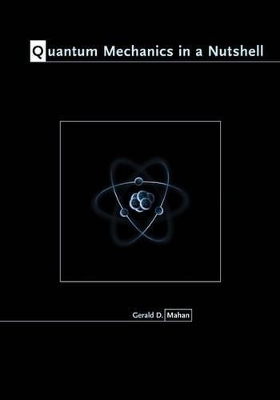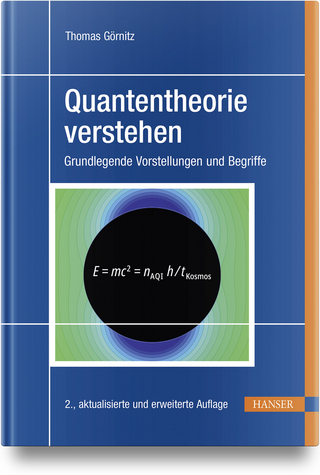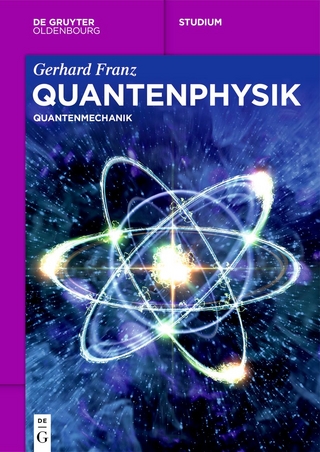
Quantum Mechanics in a Nutshell
Princeton University Press (Verlag)
9780691137131 (ISBN)
Covering the fundamentals as well as many special topics of current interest, this is the most concise, up-to-date, and accessible graduate-level textbook on quantum mechanics available. Written by Gerald Mahan, a distinguished research physicist and author of an acclaimed textbook on many-particle physics, Quantum Mechanics in a Nutshell is the distillation of many years' teaching experience. Emphasizing the use of quantum mechanics to describe actual quantum systems such as atoms and solids, and rich with interesting applications, the book proceeds from solving for the properties of a single particle in potential; to solving for two particles (the helium atom); to addressing many-particle systems. Applications include electron gas, magnetism, and Bose-Einstein Condensation; examples are carefully chosen and worked; and each chapter has numerous homework problems, many of them original. Quantum Mechanics in a Nutshell expertly addresses traditional and modern topics, including perturbation theory, WKBJ, variational methods, angular momentum, the Dirac equation, many-particle wave functions, Casimir Force, and Bell's Theorem.
And it treats many topics--such as the interactions between photons and electrons, scattering theory, and density functional theory--in exceptional depth. A valuable addition to the teaching literature, Quantum Mechanics in a Nutshell is ideally suited for a two-semester course. * The most concise, up-to-date, and accessible graduate textbook on the subject * Contains the ideal amount of material for a two-semester course * Focuses on the description of actual quantum systems, including a range of applications * Covers traditional topics, as well as those at the frontiers of research * Treats in unprecedented detail topics such as photon-electron interaction, scattering theory, and density functional theory * Includes numerous homework problems at the end of each chapter
Gerald D. Mahan is Distinguished Professor of Physics at Pennsylvania State University. He is the author of two previous physics textbooks, "Many-Particle Physics" and "Applied Mathematics".
Preface xi Chapter 1: Introduction 1 1.1 Introduction 1 1.2 Schrodinger's Equation 2 1.3 Eigenfunctions 4 1.4 Measurement 8 1.5 Representations 8 1.5.1 Schrodinger Representation 9 1.5.2 Heisenberg Representation 10 1.6 Noncommuting Operators 11 Chapter 2: One Dimension 14 2.1 Square Well 14 2.2 Linear Potentials 26 2.3 Harmonic Oscillator 29 2.4 Raising and Lowering Operators 34 2.5 Exponential Potential 39 2.5.1 Bound State 40 2.5.2 Continuum State 42 2.6 Delta-Function Potential 45 2.7 Number of Solutions 48 2.8 Normalization 49 2.8.1 Bound States 49 2.8.2 Box Normalization 50 2.8.3 Delta-Function Normalization 51 2.8.4 The Limit of Infinite Volume 54 2.9 Wave Packets 56 Chapter 3: Approximate Methods 62 3.1 WKBJ 62 3.2 Bound States by WKBJ 68 3.2.1 Harmonic Oscillator 71 3.2.2 Morse Potential 71 3.2.3 Symmetric Ramp 73 3.2.4 Discontinuous Potentials 74 3.3 Electron Tunneling 76 3.4 Variational Theory 77 3.4.1 Half-Space Potential 80 3.4.2 Harmonic Oscillator in One Dimension 82 Chapter 4: Spin and Angular Momentum 87 4.1 Operators, Eigenvalues, and Eigenfunctions 87 4.1.1 Commutation Relations 88 4.1.2 Raising and Lowering Operators 89 4.1.3 Eigenfunctions and Eigenvalues 90 4.2 Representations 95 4.3 Rigid Rotations 100 4.4 The Addition of Angular Momentum 102 Chapter 5: Two and Three Dimensions 108 5.1 Plane Waves in Three Dimensions 108 5.2 Plane Waves in Two Dimensions 112 5.3 Central Potentials 114 5.3.1 Central Potentials in 3D 114 5.3.2 Central Potential in 2D 118 5.4 Coulomb Potentials 119 5.4.1 Bound States 119 5.4.2 Confluent Hypergeometric Functions 121 5.4.3 Hydrogen Eigenfunctions 121 5.4.4 Continuum States 125 5.5 WKBJ 126 5.5.1 Three Dimensions 126 5.5.2 3D Hydrogen Atom 127 5.5.3 Two Dimensions 128 5.6 Hydrogen-like Atoms 130 5.6.1 Quantum Defect 131 5.6.2 WKBJ Derivation 132 5.6.3 Expectation Values 134 5.7 Variational Theory 134 5.7.1 Hydrogen Atom: n 1 135 5.7.2 Hydrogen Atom: l 1 136 5.7.3 Helium Atom 137 5.8 Free Particles in a Magnetic Field 143 5.8.1 Gauges 143 5.8.2 Eigenfunctions and Eigenvalues 144 5.8.3 Density of States 146 5.8.4 Quantum Hall Effect 147 5.8.5 Flux Quantization 150 Chapter 6: Matrix Methods and Perturbation Theory 157 6.1 H and H0 157 6.2 Matrix Methods 158 6.2.1 2 x 2 160 6.2.2 Coupled Spins 160 6.2.3 Tight-Binding Model 163 6.3 The Stark Effect 166 6.4 Perturbation Theory 170 6.4.1 General Formulas 170 6.4.2 Harmonic Oscillator in Electric Field 174 6.4.3 Continuum States 176 6.4.4 Green's Function 180 6.5 The Polarizability 181 6.5.1 Quantum Definition 182 6.5.2 Polarizability of Hydrogen 183 6.6 Van der Waals Potential 188 6.7 Spin-Orbit Interaction 194 6.7.1 Spin-Orbit in Atoms 195 6.7.2 Alkali Valence Electron in Electric Field 199 6.8 Bound Particles in Magnetic Fields 202 6.8.1 Magnetic Susceptibility 204 6.8.2 Alkali Atom in Magnetic Field 205 6.8.3 Zeeman Effect 207 6.8.4 Paschen-Back Effect 209 Chapter 7: Time-Dependent Perturbations 213 7.1 Time-Dependent Hamiltonians 213 7.2 Sudden Approximation 215 7.2.1 Shake-up and Shake-off 216 7.2.2 Spin Precession 218 7.3 Adiabatic Approximation 220 7.4 Transition Rates: The Golden Rule 222 7.5 Atomic Excitation by a Charged Particle 226 7.6 Born Approximation to Scattering 231 7.6.1 Cross Section 232 7.6.2 Rutherford Scattering 235 7.6.3 Electron Scattering from Hydrogen 236 7.7 Particle Decay 237 Chapter 8: Electromagnetic Radiation 244 8.1 Quantization of the Field 245 8.1.1 Gauges 246 8.1.2 Lagrangian 250 8.1.3 Hamiltonian 253 8.1.4 Casimir Force 256 8.2 Optical Absorption by a Gas 258 8.2.1 Entangled Photons 268 8.3 Oscillator Strength 269 8.4 Polarizability 273 8.5 Rayleigh and Raman Scattering 278 8.6 Compton Scattering 283 Chapter 9: Many-Particle Systems 288 9.1 Introduction 288 9.2 Fermions and Bosons 289 9.2.1 Two Identical Particles 290 9.3 Exchange Energy 291 9.3.1 Two-Electron Systems 291 9.3.2 Parahelium and Orthohelium 293 9.3.3 Hund's Rules 293 9.4 Many-Electron Systems 295 9.4.1 Evaluating Determinants 295 9.4.2 Ground-State Energy 297 9.4.3 Hartree-Fock Equations 299 9.4.4 Free Electrons 301 9.4.5 Pair Distribution Function 303 9.4.6 Correlation Energy 304 9.4.7 Thomas-Fermi Theory 304 9.4.8 Density Functional Theory 307 9.5 Second Quantization 309 9.5.1 Bosons 309 9.5.2 Fermions 312 9.6 Bose-Einstein Condensation 313 9.6.1 Noninteracting Particles 313 9.6.2 Off-Diagonal Long-Range Order 314 Chapter 10: Scattering Theory 320 10.1 Elastic Scattering 320 10.1.1 Partial Wave Analysis 323 10.1.2 Scattering in Two Dimensions 326 10.1.3 Hard-Sphere Scattering 328 10.1.4 Ramsauer-Townsend Effect 330 10.1.5 Born Approximation 332 10.2 Scattering of Identical Particles 333 10.2.1 Two Free Particles 333 10.2.2 Electron Scattering from Hydrogen 335 10.3 T-Matrices 337 10.4 Distorted Wave Scattering 340 10.5 Scattering from Many Particles 343 10.5.1 Bragg Scattering 343 10.5.2 Scattering by Fluids 344 10.5.3 Strong Scattering 346 10.6 Wave Packets 347 10.6.1 Three Dimensions 347 10.6.2 Scattering by Wave Packets 348 Chapter 11: Relativistic Quantum Mechanics 352 11.1 Four-Vectors 352 11.2 Klein-Gordon Equation 354 11.2.1 Derivation 354 11.2.2 Free Particle 354 11.2.3 Currents and Densities 355 11.2.4 Step Potential 356 11.2.5 Nonrelativistic Limit 356 11.2.6 -Mesonic Atoms 357 11.3 Dirac Equation 360 11.3.1 Derivation 361 11.3.2 Current and Charge Density 364 11.3.3 Gamma-Matrices 364 11.3.4 Free-Particle Solutions 366 11.3.5 Spin-Projection Operators 369 11.3.6 Scattering of Dirac Particles 371 11.4 Antiparticles and Negative Energy States 374 11.5 Spin Averages 377 11.6 Nonrelativistic Limit 379 11.6.1 First Approximation 379 11.6.2 Second Approximation 380 11.6.3 Relativistic Corrections for Hydrogenic States 382 11.7 Relativistic Interactions 384 11.7.1 Photon Green's Function 384 11.7.2 Electron Green's Function 387 11.7.3 Boson Exchange 387 11.8 Scattering of Electron and Muon 388 Index 397
| Erscheint lt. Verlag | 18.1.2009 |
|---|---|
| Reihe/Serie | In a Nutshell |
| Zusatzinfo | 58 line illus. |
| Verlagsort | New Jersey |
| Sprache | englisch |
| Maße | 178 x 254 mm |
| Gewicht | 1021 g |
| Themenwelt | Naturwissenschaften ► Physik / Astronomie ► Quantenphysik |
| ISBN-13 | 9780691137131 / 9780691137131 |
| Zustand | Neuware |
| Informationen gemäß Produktsicherheitsverordnung (GPSR) | |
| Haben Sie eine Frage zum Produkt? |
aus dem Bereich


